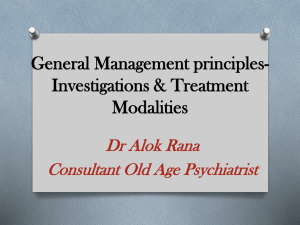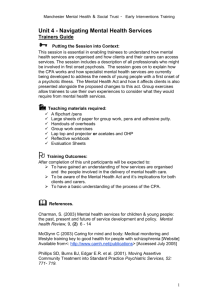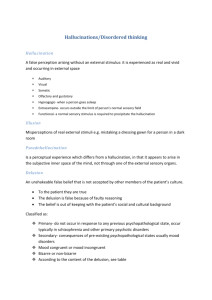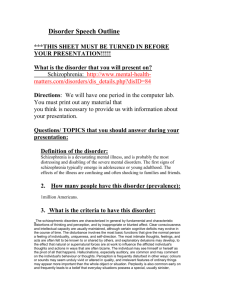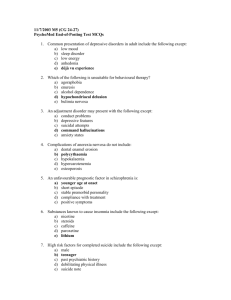103008(a).ADesai.MMathis.Schizophrenia
advertisement
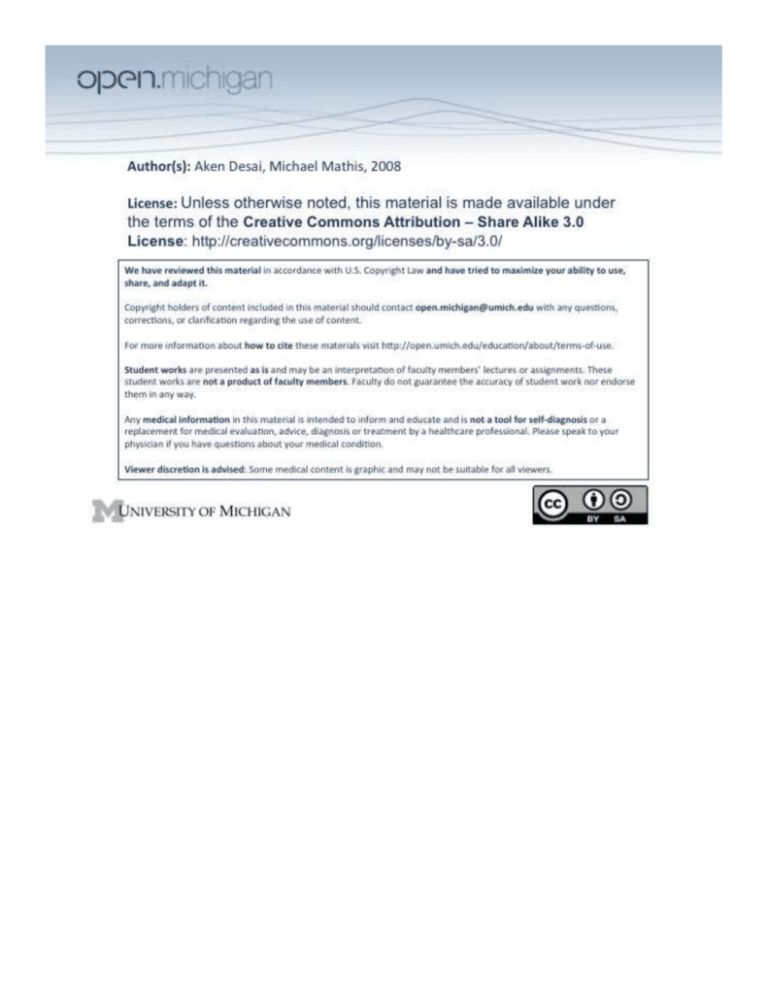
Schizophrenia Psychosis Psychosis – a significant impairment in reality testing, as evidenced by: o Hallucinations – false sensory perception in absence of stimulus (any of 5 senses) o Delusions – false belief based on incorrect inference despite obvious evidence to contrary, and not part of one’s culture o Thought Disorganization – loose associations, racing thoughts o Grossly Disorganized Behavior – meaningless/chaotic speech, bizarre behavior, catatonic Delusion Types Persecutory – belief that one is being malevolently treated in some way Referential – neutral occurrences are seen as directed toward oneself… “TV talking to me!” Religious – delusional beliefs of a spiritual or religious nature Control – thoughts, feelings, or body will feel controlled or manipulated Grandiose – inflated sense of worth, power, accomplishment, etc. Somatic – belief that one’s body is defective/altered/diseased Jealous – belief that one’s sexual partner is unfaithful Erotomanic – belief that another (often famous) person is in love with one Schizophrenia QUIZ: Schizophrenia – defined as an active psychosis accompanied by a functional deterioration Diagnostic Criteria – psychotic symptoms causing social/occupation dysfunction lasting > 6 months: o Psychotic symptoms – at least 2 (hallucinations, delusions, disorganized thought/behavior) o Social/occupational dysfunction – symptoms are impairing life & relationships o Six month duration – symptoms last for at least 6 months o Exclusion criteria met – not schizoaffective, not mood disorder, not substance abuse/medical condition, not pervasive developmental disorder (e.g. autism) Schizophrenia Subtypes Paranoid – preoccupied with delusions/hallucinations all the time, but no prominent disorganized speech/behavior, not catatonic, no flat affect; main symptom is active psychosis, but often able to maintain some level of function o Paranoia? Does not actually need to have paranoia to be paranoid schizophrenic Disorganized – prominent disorganized speech/behavior and flat/inappropriate affect; main problem is functional deterioration Catatonic – characteristic movements/speech: o Immobility – motoric immobility, catalepsy (waxy flexibility), or stupor, or… o Excessive mobility – purposeless motor activity o Negativism – motiveless resistance to instructions, or mutism o Peculiarities of movement/posture – stereotyped movements, prominent mannerism, grimacing o Echolalia/Echopraxia – mimicking words/gestures Undifferentiated – no one element predominates (some disorganization/catatonia/delusions) Residual – nothing immediately apparent about patients; no delusion/hallucination/disorganization, but… o Evidence of disturbance – still there, can show flat affect, impaired function, attenuated psychosis, odd beliefs, unusual perceptions Schizophrenia Descriptions Positive Symptoms – presence of delusions, hallucinations, thought disorganization Negative Symptoms – characterized by absences: o Blunted affect – decreased expression, vocal inflection, eye contact, gestures o Alogia – reduced speech/ideas, thought blocking o Avolition/apathy – poor grooming/hygiene, low energy o Anhedonia/Asociality – loss of recreational interests, low sexual activity, absence of intimacy o Inattention – socially uninvolved, “spacey” Cognitive Impairment – poor memory, language, attention, and poor executive function (doing tasks); IQ<85 Schizophrenia QUIZ: Onset – prodromal symptoms can be present at birth or may precede psychosis by months/years: o Poor social adjustment – few friends o Poor school & work performance – low IQ o Negative symptoms, pecularities in thoughts/behavior o Peak age of onset – onset is active psychosis men 17-30, women 20-40 Prognosis – 10% of patients recover completely; 75% relapse if untreated, 20% relapse if antipsychotics Treatment – antipsychotics reduce 1-year relapse 7520%, 10-15% of patients only respond to clozapine Clinical Course – prodromal symptoms months-years before, (+) Sx episodic, (-) and cognitive Sx progressive and do not respond well to treatment; residual Sx remain even w/ treatment Schizophrenia Complications Suicide – 10% of deaths in schizophrenics, more common in higher functioning ones (paranoid) Depression – occurs in 50% of cases, often after acute episode Homelessness – 30-35% of patients homeless, very vulnerable Crime – 4-fold increase in violence compared to general population; victims of crimes too Substance abuse – 90% smoke, likely 60-70% abuse substances Schizophrenia Epdemiology Prevalence – lifetime risk 1%; over-representation in lower class from downward drift; genetic component o Genetic link – 10% risk in 1st degree relatives; 50% in monozygotic twins suggests factors outside of genetics; multi-gene involvment, but no specific gene o In-utero (2nd trimester) / perinatal infection – linked to incidence of schizophrenia later in life; winter births; toxic exposure, perinatal anoxia all interruptions of neuronal development Schizophrenia Pathophysiology Dopamine – increased dopamine activity in schizophrenia, affect many CNS pathways in brain o Subcortex – increased dopamine activity positive symptoms o Prefrontal – decreased dopamine activity negative symptoms Evidence – increased dopamine receptors at autopsy, dopamine agonists worsen psychosis & vice-versa Ventricle-to-brain Ratio – enlarged ventricles in 50% of schizophrenics; not associated w/ any specific structure (global 10% loss of brain mass) Other hypotheses – alterations in glutamate neurotranmission at NMDA receptor; aberrant GABA NT in dorsolateral prefrontal cortex Schizophrenia Treatment Antipsychotics – only effective drug treatment, include conventional neuroleptics and atypical (clozapine) Psychosocial – case management, give social skills training, reduce “expressed emotion” w/ family psychoeducation Manic Episode Psychosis Prevelance – 80% of manic episodes 1% lifetime risk Symptoms – mood congruent; indistinguishable from psychosis of schizophrenia, catatonia, insight good btwn episodes Treatment – antipsychotics for acute episodes, mood stabilizers during episodes and for prevention Major Depressive Episode w/ Psychotic Features Prevelance – 10% of depressed pts develop features lifetime risk of 1%; mood disorders are 2x more likely to cause psychosis vs schizophrenia Treatment – ECT; antipsychotic + antidepressant trial but usually move quickly to ECT Schizoaffective Disorder Schizoaffective Disorder – patient has psychosis w/ on/off periods of mood disorder (depression/manic) Diagnostic Criteria – schizophrenia + mood disorder criteria, essentially Prevalence – less common than schizophrenia Treatment – treat schizophrenia + mood disorder antipsychotic + antidepressant/mood stabilizer Delusional Disorder Delusional Disorder – disorder of delusions only, without any other symptoms/impairments Diagnostic Criteria – isolated non-bizarre delusions, no other symptoms or impairments Onset – middle to late life, very rare; variable course Treatment – antipsychotics but response isn’t very good Brief Psychotic Disorder Brief Psychotic Disorder – psychosis which quickly resolves, with no impairment Predisposing factors – personality disorders (paranoid, borderline, histrionic, narcissitic, schizotypal) Course – rapid onset and resolution Treatment – one course of antipsychotics, or often just supportive care Shared Psychotic Disorder Shared Psychotic Disorder “Folie a Deux” – a delusion developing in context of close relationship to another person with an established delusion; separation will show who has true psychosis Substance-Induced Psychotic Disorder Intoxication Psychosis – alcohol, amphetamine (MDMA), cannabis, cocaine, hallucinogens, inhalants, opioids, PCP, sedatives, hypnotics, anxiolytics Withdrawal Psychosis – alcohol, sedatives, hypnotics, anxiolytics Medical Treatment Psychosis – high-dose steroids, L-Dopa (Parkinson’s) Psychotic Disorders Due to Medical Condition Medical Cause – neurological, metabolic (hypoxia, hypoglycemia, etc.), endocrine, other Delirium (acute brain failure) or Dementia (chronic brain failure – Alzheimer’s, etc.)


